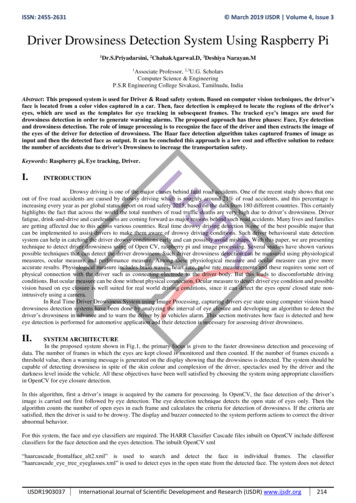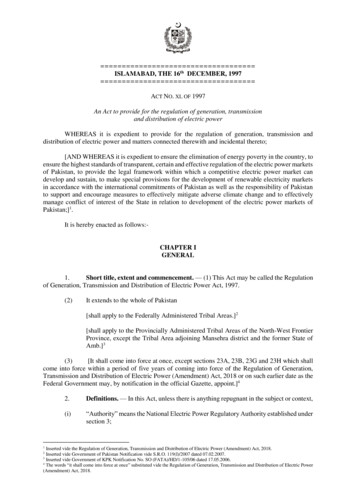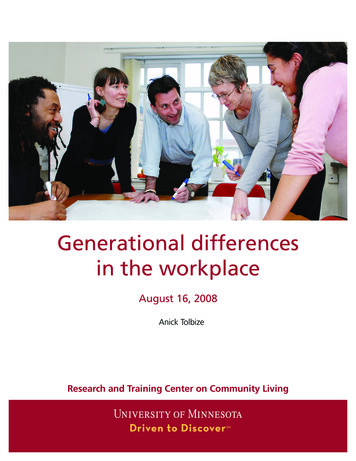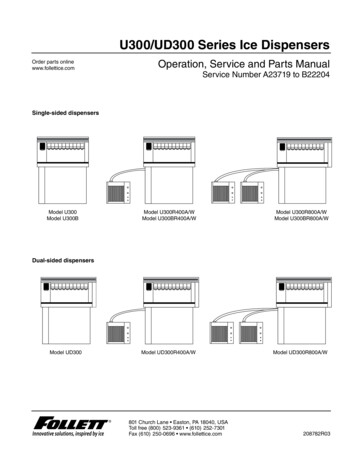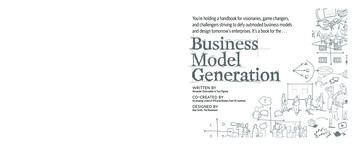
Transcription
Business Model Generation is a practical,inspiring handbook for anyone striving to improvea business model — or craft a new one.change the way you think about business modelsBusiness Model Generation will teach you powerful andpractical innovation techniques used today by leadingcompanies worldwide. You will learn how to systematicallyunderstand, design, and implement a new businessmodel — or analyze and renovate an old one.co-created by 470 strategy practitionersBusiness Model Generation practices what it preaches.Coauthored by 470 Business Model Canvas practitionersfrom forty-five countries, the book was financed andproduced independently of the traditional publishingindustry. It features a tightly integrated, visual, lie-flatdesign that enables immediate hands-on use.designed for doersDisruptive new business models areemblematic of our generation.Yet they remain poorly understood,even as they transform competitivelandscapes across industries.Business Model Generation offersyou powerful, simple, tested tools forunderstanding, designing, reworking,and implementing business models.You’re holding a handbook for visionaries, game changers,and challengers striving to defy outmoded business modelsand design tomorrow’s enterprises. It’s a book for the . . .written byBusiness Model Generation is for those ready to abandonoutmoded thinking and embrace new, innovativemodels of value creation: executives, consultants,entrepreneurs — and leaders of all organizations.Alexander Osterwalder & Yves Pigneurco-created byAn amazing crowd of 470 practitioners from 45 countries 34.95 USA/ 41.95 CANdesigned byAlan Smith, The Movement2/C: PANTONE PMS COOL GRAY 11 M PROCESS BLACK
TheLongTailbmgen final.indd 666/15/10 5:35 PM
long tail business models are about selling lessof more: They focus on oΩering a large numberof niche products, each of which sells relativelyX]UaT dT]c[h } 0VVaTVPcT bP[Tb U ]XRWT XcT\b can be as lucrative as the traditional modelwhereby a small number of bestsellers accountU a \ bc aTeT]dTb } ; ]V CPX[ QdbX]Tbb \ ST[b THE LONG TAIL[ ref·er·ences ]1 } CWT ; ]V CPX[) FWh the Future of Business8b BT[[X]V ;Tbb U aT67PATTERNSDef Pattern No. 2Anderson, Chris. 2006.2 } “The Long Tail.” Wired PVPiX]T Anderson,Chris. October 2004.[ ex·am·ples ]Netflix, eBay, YouTube,Facebook, Lulu.comrequire low inventory costs and strong platforms to make niche content readily availableto interested buyers.bmgen final.indd 676/15/10 5:35 PM
TOP20%Focus on a smallnumber of products,# of SalesTheLongeach selling in high volumeTailconceptwas coined byChris Andersonto describe a shift inthe media business fromselling a small number of “hit”items in large volumes towardselling a very large number of nicheitems, each in relatively small quantities.Anderson described how many infrequent salescan produce aggregate revenues equivalent to oreven exceeding revenues produced by focusing onsimple“hit” products.softwarewith professionalAnderson believes three economic triggers gaveresults.rise to this phenomenon in the media industry:2. Democratization of distribution: The Internet3. Falling search costs to connect supply with1. Democratization of tools of production: Fallinghas made digital content distribution a commod-demand: The real challenge of selling niche contenttechnology costs gave individuals access to toolsity, and dramatically lowered inventory, commu-is finding interested potential buyers. Powerfulthat were prohibitively expensive just a few yearsnications, and transaction costs, opening up newsearch and recommendation engines, user ratings,ago. Millions of passionate amateurs can nowmarkets for niche products.and communities of interest have made thisrecord music, produce short films, and designbmgen final.indd 68much easier.6/15/10 5:35 PM
THE LONG TAILPATTERNS69LONG TAIL Focus on a large number of products, each selling in low volumesAnderson’s research focuses primarily on the mediamovie is rented relatively infrequently, aggregateconcept applies outside the media industry as well.industry. For example, he showed how online videorevenue from Netflix’s vast niche film catalog rivalsThe success of online auction site eBay is based onrental company Netflix moved toward licensing athat from the rental of blockbuster movies.a huge army of auctioneers selling and buying smalllarge number of niche movies. While each nicheBut Anderson demonstrates that the Long Tailquantities of “non-hit” items.# of Productsbmgen final.indd 696/15/10 5:35 PM
THE LONG TAILThe Transformation of theBook Publishing IndustryPATTERNS70Old ModelWe’ve all heard about aspiring authors who carefully craft and submitmanuscripts to publishing houses in the hope of seeing their work incontentacquisitionprint—and face constant rejection. This stereotypical image of publisherspublishingsalesand authors holds much truth. The traditional book publishing modelis built on a process of selection whereby publishers screen many authorsand manuscripts and select those that seem most likely to achieve minimum sales targets. Less promising authors and their titles are rejectedbecause it would be unprofitable to copyedit, design, print, and deally"hits")broadaudienceretailnetworkbooks that sell poorly. Publishers are most interested in books they canprint in quantity for sale to large audiences.publishing / marketingbmgen final.indd 70wholesale revenues6/15/10 5:35 PM
THE LONG TAILPATTERNS71A New ModelLulu.com turned the traditional bestseller-centric publishing model onbased on helping niche and amateur authors bring their work to market.logisticsIt eliminates traditional entry barriers by providing authors the tools tocraft, print, and distribute their work through an online marketplace. Thiscontrasts strongly with the traditional model of selecting “market-worthy”work. In fact, the more authors Lulu.com attracts, the more it succeeds,because authors become customers. In a nutshell, Lulu.com is a multi-communitiesof interestplatformdevelopmentits head by enabling anyone to publish. Lulu.com’s business model ing servicesonlineprofilemarketplacefor d platform (see p. 76) that serves and connects authors and readerswith a Long Tail of user-generated niche content. Thousands of authorsuse Lulu.com’s self-service tools to publish and sell their books. Thisplatform management& developmentsales commissions (low)publishing service feesworks because books are printed only in response to actual orders. Thefailure of a particular title to sell is irrelevant to Lulu.com, because sucha failure incurs no costs.bmgen final.indd 716/15/10 5:35 PM
THE LONG TAILLEGO ’s New Long TailPATTERNS72The Danish toy company LEGO started manu-This requires transforming the supply chainfacturing its now famous interlocking bricksinfrastructure, and because of low volumesin 1949. Generations of children have playedLEGO has not yet fully adapted its supportwith them, and LEGO has released thousandsinfrastructure to the new LEGO Factory model.of kits around a variety of themes, includingInstead, it simply tweaked existing resources space stations, pirates, and the Middle Ages. Butand activities.LEGOindustry forced LEGO to seek innovative newtook a step beyond mass customization by enter-LEGO users can maketheir own designsand order them onlinepaths to growth. It started licensing the rightsing Long Tail territory. In addition to helping to use characters from blockbuster movies suchusers design their own LEGO sets, LEGO Fac-LEGO Factoryas Star Wars, Batman, and Indiana Jones. Whiletory now sells user-designed sets online. Somesuch licensing is expensive, it proved to be ansell well; some sell poorly or not at all. What’s impressive revenue generator.important for LEGO is that the user-designedover time, intensifying competition in the toyIn terms of a business model, though, LEGOuser-generated content. It introduced LEGOon a limited number of best-selling kits. TodayLEGO allows usersto post and sell theirdesigns onlineFactory, which allows customers to assemblethis aspect of LEGO’s business accounts for only their very own LEGO kits and order thema small portion of total revenue, but it is a firstLEGO Users Catalogonline. Using software called LEGO Digitalstep towards implementing a Long Tail modelDesigner, customers can invent and design theiras a complement—or even alternative—to aown buildings, vehicles, themes, and characters,traditional mass-market model.In 2005 LEGO started experimenting withsets expand a product line previously focusedchoosing from thousands of components anddozens of colors. Customers can even design thebox containing the customized kit. With LEGOFactory, LEGO turned passive users into activeparticipants in the LEGO design experience.bmgen final.indd 726/15/10 5:35 PM
THE LONG TAILPATTERNS74Long TailPatternbmgen final.indd 746/15/10 5:35 PM
THE LONG TAILLong Tail business modelsfocus on niche customers.A Long Tail business modelcan serve both professional and amateur contentproducers, and may createa multi-sided platform (seep. 76) catering to users andproducers alike.75PATTERNSNiche content providers(professional and/oruser-generated) are thekey partners in this pattern.The value proposition ofa Long Tail business modelis characterized by oΩeringa wide scope of “non-hit”items that may co-existwith “hit” products. LongTail business models mayalso facilitate and build onuser-generated content.KPKAVPCRCSThe key resource is theplatform; key activitiesinclude platform development and maintenance andniche content acquisitionand production.KRC CHR The main costs incurredcover platform developmentand maintenanceThis model is based onaggregating small revenuesfrom a large number ofitems. revenue streamsvary; they may come fromadvertising, product sales,or subscriptions.bmgen final.indd 75Long Tail business modelsusually rely on the Internetas a customer relationshipand/or transaction channel.6/15/10 5:35 PM
Business Model Generation is a practical,inspiring handbook for anyone striving to improvea business model — or craft a new one.change the way you think about business modelsBusiness Model Generation will teach you powerful andpractical innovation techniques used today by leadingcompanies worldwide. You will learn how to systematicallyunderstand, design, and implement a new businessmodel — or analyze and renovate an old one.co-created by 470 strategy practitionersBusiness Model Generation practices what it preaches.Coauthored by 470 Business Model Canvas practitionersfrom forty-five countries, the book was financed andproduced independently of the traditional publishingindustry. It features a tightly integrated, visual, lie-flatdesign that enables immediate hands-on use.designed for doersDisruptive new business models areemblematic of our generation.Yet they remain poorly understood,even as they transform competitivelandscapes across industries.Business Model Generation offersyou powerful, simple, tested tools forunderstanding, designing, reworking,and implementing business models.You’re holding a handbook for visionaries, game changers,and challengers striving to defy outmoded business modelsand design tomorrow’s enterprises. It’s a book for the . . .written byBusiness Model Generation is for those ready to abandonoutmoded thinking and embrace new, innovativemodels of value creation: executives, consultants,entrepreneurs — and leaders of all organizations.Alexander Osterwalder & Yves Pigneurco-created byAn amazing crowd of 470 practitioners from 45 countries 34.95 USA/ 41.95 CANdesigned byAlan Smith, The Movement2/C: PANTONE PMS COOL GRAY 11 M PROCESS BLACK
Business Model Generation offers you powerful, simple, tested tools for understanding, designing, reworking, and implementing business models. Business Model Generation is a practical, inspiring handbook for anyone striving to improve a business model — or craft a new one. change the way you think about business models


